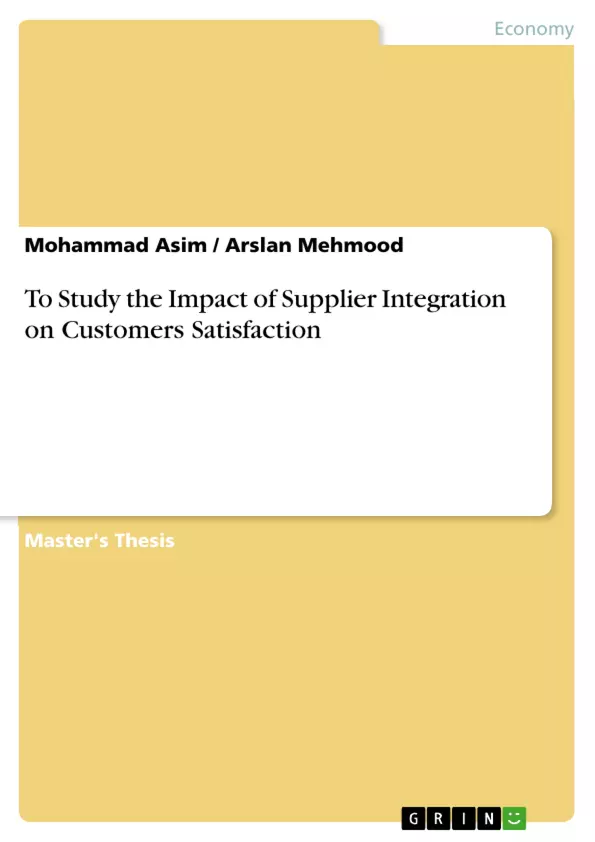This work focuses on the impact of supplier integration on customers satisfaction. Supply chain processes and their integration is a subject that has recently been studied a lot in terms of figuring out how these processes effect the organization in the long run. The usages of proper supply chain processes have shown a great deal of effect on the organizations production.
In this research I have chosen to focus on how supplier integration in the supply chain processes of an organization can affect the organization performance in terms of consumer’s integration. It has been seen through the study of previous literature from the studies conducted on similar topics that an organization‘s performance has a huge impact on the firm’s consumer performance. Consumer performance is measured by how many consumers are interested in purchasing from the organization and whether consumers are satisfied with their purchases from the organization. In terms of supplier integration it has been seen from previous researches that by allowing a supplier to take over the production or a apart of the production of the organization the organization is free to now look into other aspects of the firm thus adding more value to the organization by increasing not only its production but also its performance.
For this research a quantitative approach has been taken in order to justify the findings in proper quantifiable terms. This methodology allows us to look into how many people believe the stance that we are taking for our research and how many chose to take a different route. This can also help us in testing our hypothesis as to whether or not our chosen variables actually work well with one another or whether they don’t. Looking at the results that were collected through the usage of SPSS it has been proven that our independent variables (supplier integration and consumer performance) do have an impact on one another as well as a significant impact on our dependent variable (firm’s performance).
Inhaltsverzeichnis (Table of Contents)
- 1.1 Introduction
- 1.2 Background
- 1.3 Problem Statement
- 1.4 Research Question
- 1.5 Research Objective
- 1.6 Contribution
- 2.1 Literature Review
- 2.1.1 Supplier Integration
- 2.1.2 Consumer Performance
- 2.1.3 Manufacturing Flexibility
- 2.2 Gaps in Literature
- 3.1 Methodology
- 3.2 Research technique
- 3.2.1 Time Series
- 3.3 Research Questions
- 3.4 Hypothesis Development
- 3.5 Structured Tools
- 3.6 Target Audience
- 3.7 Limitations
- Results and Discussions
- 4.1 Descriptive Analysis
- 4.2 Summary
- 4.3 Summary of Methodology
- 4.4 Summary of Findings
- 4.5 Implications of the study
- 4.6 Limitations of the study
- 4.7 Future study Prospects
Zielsetzung und Themenschwerpunkte (Objectives and Key Themes)
This research aims to explore the impact of supplier integration on a firm's production and customer satisfaction. It investigates how the addition of a supplier can influence a firm's production process and ultimately contribute to customer satisfaction.
- The impact of consumer satisfaction on a firm's production.
- The impact of supplier integration on a firm's production and performance.
- The relationship between supplier integration and customer satisfaction in relation to a firm's performance.
- The role of supplier integration in enhancing a firm's service capabilities and manufacturing flexibility.
- The influence of supply chain integration on customer satisfaction and product performance in the context of globalization.
Zusammenfassung der Kapitel (Chapter Summaries)
- Introduction: This chapter provides a foundational overview of the research topic, highlighting the importance of supply chain integration and its influence on organizational performance. It also establishes the research problem, questions, and objectives.
- Literature Review: This chapter delves into existing research on supplier integration, consumer performance, and manufacturing flexibility. It examines how these concepts interrelate and contribute to a firm's overall success.
- Methodology: This chapter outlines the research methodology employed, including the quantitative approach, research techniques, and data analysis methods used to collect and analyze information.
- Results and Discussions: This section presents and analyzes the findings of the research, exploring the relationship between supplier integration, customer satisfaction, and firm performance. It examines the implications of the study and identifies potential limitations.
Schlüsselwörter (Keywords)
The primary focus of this research lies in understanding the influence of supplier integration on customer satisfaction and firm performance. Key concepts explored include supplier integration, customer satisfaction, manufacturing flexibility, service capabilities, supply chain processes, and the impact of globalization on consumer behavior and product performance.
- Quote paper
- Dr. Mohammad Asim (Author), Arslan Mehmood (Author), 2019, To Study the Impact of Supplier Integration on Customers Satisfaction, Munich, GRIN Verlag, https://www.grin.com/document/495978



